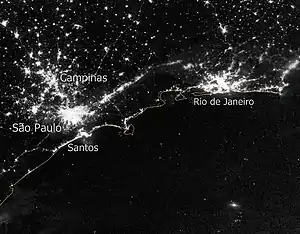
The Rio de Janeiro–São Paulo Megalopolis, also known as the Brazilian Megalopolis[1] is a megalopolis in Southern Brazil consisting of the cities of Rio de Janeiro and São Paulo, as well as their surrounding urban areas.
In 1999, Brian J. Godfrey wrote: "Even as Rio de Janeiro and Sao Paulo have sprawled to form the two main nuclei of an integrated megalopolis with a current population of between 30 and 60 million in southeastern Brazil, the two cities retain distinguishing characteristics."[2]
In 2003, Jean Gottman, who studied the Northeast megalopolis in the 1960s, also suggested the formation of this megalopolis. [3]
The entire Rio–São Paulo area is also sometimes considered a conurbation,[4] and plans are in the works to connect the cities with a high-speed rail. Yet the government of Brazil does not consider this area a single unit for statistical purposes, and any population numbers would be synthetic. Another estimate published by Stanley D. Brunn, et al. suggests a population of 50 million.[4]
As of December 2013, Rio de Janeiro to São Paulo is the third-busiest air traffic route by passenger volume, according to Amadeus.[5]
References
- ↑ Universidade Federal do Rio de Janeiro (UFRJ), ed. (2007). "A megalópole brasileira" (PDF). Archived from the original (PDF) on 10 November 2013. Retrieved 17 February 2014.
- ↑ Godfrey, Brian J. (Jan 1999). "Revisiting Rio de Janeiro and Sao Paulo". Geographical Review. 89 (1): 94–121.
- ↑ Perović, Miloš; Gottmann, Jean (May–August 2003). "An interview with Jean Gottmann on urban geography". Ekistics. 70 (420–421): 140–146.
- 1 2 Brunn, Stanley D.; Graybill, Jessica K.; Hays-Mitchell, Maureen; Zeigler, Donald J., eds. (2020). Cities of the World: Regional Patterns and Urban Environments (Seventh ed.). Rowman & Littlefield Publishers. p. 158–159. ISBN 9781538126356.
- ↑ "300 world 'super routes' attract 20% of all air travel, Amadeus reveals in new analysis of global trends". Amadeus. 16 April 2013.